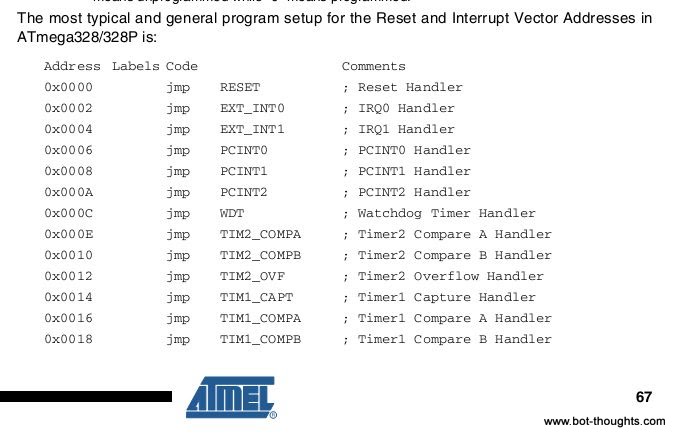

- INTERRUPT VECTOR TABLE EMU8086 HOW TO
- INTERRUPT VECTOR TABLE EMU8086 SOFTWARE
- INTERRUPT VECTOR TABLE EMU8086 CODE
- INTERRUPT VECTOR TABLE EMU8086 WINDOWS
This sample shows the use of input and output string functions of emu8086.inc. INTERRUPT VECTOR TABLE EMU8086 CODE
A very handy code that can be assembled into a very tiny utility to make floppy boot records and tiny operating systems. This example converts 2 digit Hex value into numeric value and decimal string representation (so that it can be easily printed if required). INTERRUPT VECTOR TABLE EMU8086 WINDOWS
This example prints out The easiest and the fastest way to print "Hello World!" using DOS INT 21h (still works under Windows XP in Dos prompt).This program calculates linear equation: ax + b = 0 The result is printed with floating point.Call a procedure from another segment or interrupt.This sample gets the number from the user, and calculates factorial for it.
 Make your own interrupts - Custom_Interrupt.asm.
Make your own interrupts - Custom_Interrupt.asm. INTERRUPT VECTOR TABLE EMU8086 HOW TO
This sample shows how to use CMPSW instruction to compare strings.This sample gets two numbers from the user, calculates the sum of these numbers, and prints it out.This is an example of AAS instruction, it is used to subtract huge BCD numbers.Learn how to set and get file attributes, in other words how to make file Read Only or Hidden.See how to operate with Octal, Binary and Decimal values.
 Calculate the sum of elements in V1 array, store result in V2. This example shows how to add huge unpacked BCD numbers. Your own Operating System that runs from floppy drive - easy! This is a very basic example of a tiny OS. Input 8 bit binary number and print out its decimal equivalent. The opcode for INTO is 0xCE, however it is unavailable in x86-64 mode.Here is the list of programs in assembly language with complete source code is providedĪssembler Source Code for emu8086 microprocessor emulator and compatible assemblers (16 bit) simply copy these codes and past them on your editor It is a conditional interrupt which is triggered when the overflow flag is set at the time of executing this opcode. The INTO instruction is another one-byte-instruction. Since the dedicated 0xCC opcode has some desired special properties for debugging, which are not shared by the normal two-byte opcode for an INT3, assemblers do not normally generate the generic 0xCD 0x03 opcode from mnemonics. The opcode for INT3 is 0xCC, as opposed to the opcode for INT immediate8, which is 0xCD immediate8. This makes them unsuitable for use in patching instructions (which can be one byte long) see SIGTRAP. The more general INT XXh instructions are encoded using two bytes. The INT3 instruction is a one-byte-instruction defined for use by debuggers to temporarily replace an instruction in a running program in order to set a code breakpoint. This is accomplished by entering a 32-bit value corresponding to a kernel function into the EAX register of the processor and then executing INT 0x80.
Calculate the sum of elements in V1 array, store result in V2. This example shows how to add huge unpacked BCD numbers. Your own Operating System that runs from floppy drive - easy! This is a very basic example of a tiny OS. Input 8 bit binary number and print out its decimal equivalent. The opcode for INTO is 0xCE, however it is unavailable in x86-64 mode.Here is the list of programs in assembly language with complete source code is providedĪssembler Source Code for emu8086 microprocessor emulator and compatible assemblers (16 bit) simply copy these codes and past them on your editor It is a conditional interrupt which is triggered when the overflow flag is set at the time of executing this opcode. The INTO instruction is another one-byte-instruction. Since the dedicated 0xCC opcode has some desired special properties for debugging, which are not shared by the normal two-byte opcode for an INT3, assemblers do not normally generate the generic 0xCD 0x03 opcode from mnemonics. The opcode for INT3 is 0xCC, as opposed to the opcode for INT immediate8, which is 0xCD immediate8. This makes them unsuitable for use in patching instructions (which can be one byte long) see SIGTRAP. The more general INT XXh instructions are encoded using two bytes. The INT3 instruction is a one-byte-instruction defined for use by debuggers to temporarily replace an instruction in a running program in order to set a code breakpoint. This is accomplished by entering a 32-bit value corresponding to a kernel function into the EAX register of the processor and then executing INT 0x80. INTERRUPT VECTOR TABLE EMU8086 SOFTWARE
Most Unix systems and derivatives do not use software interrupts, with the exception of interrupt 0x80, used to make system calls. By calling it with different parameters in the registers (mostly ah and al) you could access various IO operations, string output and more. One of the most useful DOS software interrupts was interrupt 0x21. It is therefore entirely possible to use a far-call instruction to start the interrupt-function manually after pushing the flag register. When generating a software interrupt, the processor calls one of the 256 functions pointed to by the interrupt address table, which is located in the first 1024 bytes of memory while in real mode (see Interrupt vector).







 0 kommentar(er)
0 kommentar(er)
